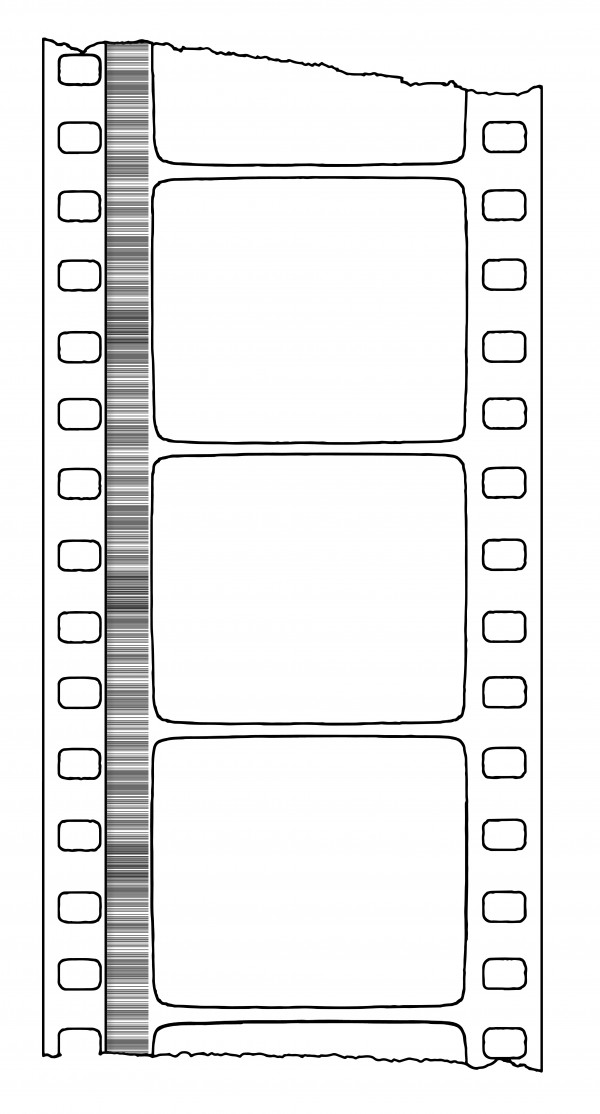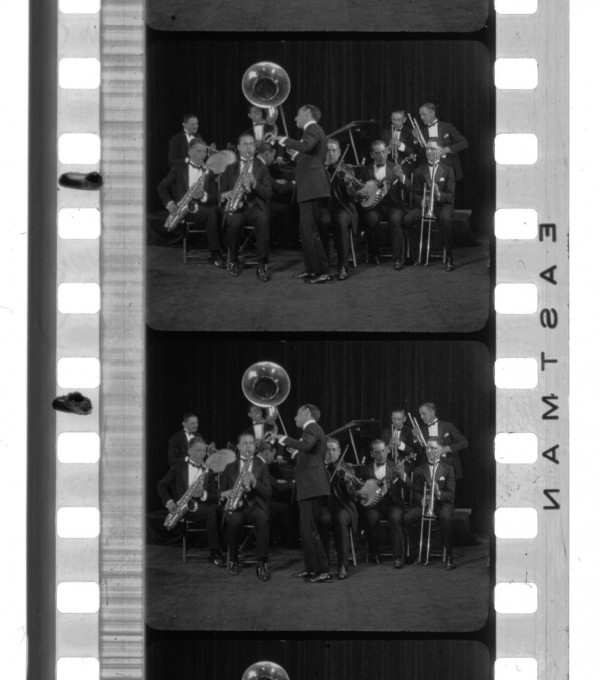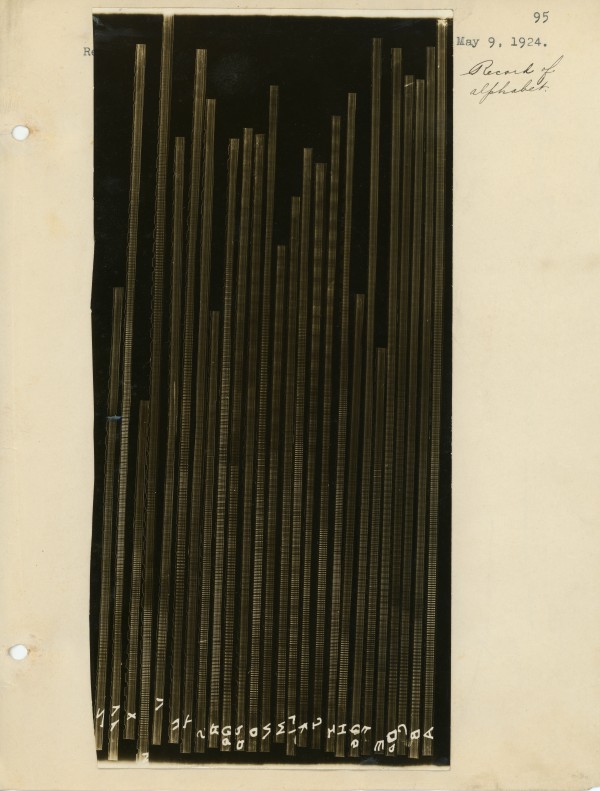A variable-density, single-system optical sound technology developed by the Case Research Laboratory in Auburn, NY, United States. In its commercial form, when paired with Western Electric microphones, amplifiers and loudspeakers, the system later became known as Movietone sound.
Film Explorer

Identification
Unknown
B/W Kodak
Kodak
1
All tests were B/W only.
Unknown, though Case did request that DeForest credit “Taken by Case Studios” on at least one occasion (Przyblek, 1999: p. 71).
Single-system, variable-density. Both the image and audio were exposed in-camera on the same negative with an 11-frame offset. When printed for projection the combined, single-system was retained with the offset adjusted for the projector.
21.97mm x 18.997mm (0.865 in x 0.748 in).
B/W
Kodak
History
The Case Research Lab (CRL) was a private scientific research company founded by Theodore Case in Auburn, NY, United States. Case hired Earl I. Sponable in 1916, and the two men worked closely together for the next ten years. Together, they conducted work for the US Navy during World War I, and through this research developed a highly responsive photoelectric vacuum cell that CRL marketed as the “Thalofide Cell”.
CRL began working in the developing field of sound recording, through the lab’s affiliation with Lee DeForest and his Phonofilm optical-sound project. In 1922, CRL began supplying Thalofide Cells for use in the sound reproduction of Phonofilm recordings and engaged in regular consultations with DeForest. At the time, DeForest was using commercially available flashlight bulbs to create Phonofilm, a system of variable-density soundtrack, exposed onto the same negative as the image. Variable electrical signals from a microphone were used to correspondingly vary the intensity of an exposing light source. The density of the exposed film stripe varied in proportion to the intensity of this lamp, creating graded striations, from light to dark. CRL made a critical breakthrough in December 1922, when Case developed a helium-filled gas discharge tube that could modulate more rapidly, and through a greater range of intensity, than the bulbs thus far used by DeForest. CRL’s glow lamp design, known as an Aeo light, resulted in sound negatives superior to those produced using DeForest’s method.
February 1923 should be seen as the start date of CRL optical sound recordings in earnest. A new “camera” (a modified projector) was refined over the winter of 1923. This gave CRL the ability to record and reproduce longer optical sound films within a research laboratory setting. Surviving CRL notebooks record a methodical, scientific approach to the problem, with variables being adjusted and results documented. Through 1923 and 1924, CRL developed an ever-stronger understanding of the principles of optical sound recording, which, from this stage on, became the primary focus of the lab’s activity.
CRL’s methodical approach to addressing the existing shortcomings identified in optical sound recordings, contrasted dramatically with DeForest’s. In spring 1923, DeForest presented Phonofilm to the public, first through a press event in March, and then a larger public demonstration, in April at the Rivoli Theatre in Manhattan, New York – this, despite Case believing Phonofilm needed more refinement before going fully public. Throughout 1923, CRL notebooks and correspondence document Case’s growing frustration with DeForest and his penchant for showmanship over science and engineering. On several occasions, Sponable, Case and other CRL staff visited Phonofilm operations in New York to troubleshoot Phonofilm’s studio equipment. In early August 1924, Case, Sponable and others traveled to Washington, DC, to film US President Calvin Coolidge on the White House grounds, and Senator Robert LaFollette at the Capitol Building. While the recordings were arranged by Phonofilm staff, all the equipment used, as well as its operators, were provided by CRL. DeForest failed to duly credit CRL when these historic films were subsequently exhibited (Przyblek, 1999: p. 71).
Frustrated with the poor state of engineering at Phonofilm studio, with Phonofilm’s early theater installations and distribution practices, and leery of DeForest’s intentions to claim CRL innovations as his own, Case determined to develop a complete system for optical sound at his lab in Auburn without the involvement of DeForest. Although Case began to distance his lab from DeForest, contractual arrangements kept the two men linked through the remainder of 1924 (Przyblek, 1999: p. 74).
In August 1924, Case began construction work on a purpose-built studio in the attic of the carriage house on his Auburn estate. Once completed, the carriage house studio became the center of CRL’s filmmaking activities. Over 150 sound shorts had been filmed at CRL by the end of November 1926 (CRL Lab Notebook No. 1: “Studio Sound Tests”). These featured local musicians as well as vaudeville acts traveling through the area. Surviving films from this period are preserved at the George Eastman Museum in Rochester, NY. Preserved CRL Lab Notebook No. 12 includes positive frames cut from various films shot during 1925.
Throughout 1925, CRL focused its energy on perfecting its system and assessing potential strategies for the commercial exploitation of their technologies. With experience of making test films in the carriage house studio, CRL initially explored the idea of recording and distributing films as the path to commercialization. To do this it needed a license for the use of proprietary amplification technology, from either General Electric, or Western Electric. CRL’s attempt to secure such a license through the winter of 1925/26 proved unsuccessful (Sponable, 1947: pp. 296–301), but Case proceeded to incorporate the Zoephone Company as the prospective brand for films to be produced and distributed by CRL.
Unable to secure an amplification license for himself, Case decided to partner up with an established film company to bring CRL sound to audiences. In July 1926, Case went into business with William Fox through the formation of the Fox-Case Corporation. Fox-Case Corp. signed a license with Western Electric for amplification on December 31, 1926, and premiered its first films in February 1927. These two contracts effectively brought an end to CRL sound as an entity, with their groundbreaking technologies subsequently becoming known as Fox Movietone.
Selected Filmography
Test film, unreleased.
Test film, unreleased.
Filmed in May 1925, in Auburn, New York.
Filmed in May 1925, in Auburn, New York.
Technology
The earliest Case Research Lab (CRL) variable-density sound recordings (1922–23) were sound-only films, produced by modifying a projector for use as both a recorder and reproducer of short audio tests. Single-system recording (image and sound on the same negative) began in March 1924, using a modified Bell & Howell camera and Simplex projector. A Bell & Howell Model D printer, modified to accommodate sound and image, was also purchased to complete the operations.
To avoid wow distortion, recorded sound of any form requires transport of the recording medium at constant speed. This problem was clear to Case and Sponable, and the Case optical-sound camera underwent an ongoing series of modifications to achieve constant speed. Sponable was instrumental in this work and his contributions to the final camera design cannot be overestimated. Through 1924 and 1925, he worked with Bell & Howell and the Precision Machine Company (makers of Simplex projectors) to address inadequacies, machining tolerances, and adjust initial designs. However, only after the camera was overhauled by Doyle-Wall Machine & Tool Co. in nearby Syracuse, did Sponable’s concepts for achieving constant speed succeed.
The variable-density soundtrack was generated by the rapid modulation of a glow lamp (called an Aeo light) mounted close to the film in-camera. The Aeo light was an evolving technology, with the lab making ongoing improvements throughout this period – as a result, early CRL optical sound recordings have noticeably different characteristics compared to those made in later years. In addition to Sponable’s designs to achieve a constant speed at the main sprocket of the camera, high-quality sound reproduction was dependent upon a highly engineered metal tube and ‘shoe’ that held the Aeo light tightly in position and permitted only a thin slit of light to pass through the film stock. The shoe fitted tightly against the central sprocket, in a manner that allowed sprocket teeth to pass through, and ended with a small piece of quartz which had a thin coating of silver applied to one of its sides. Into this silver layer was etched a very narrow slit (0.001 in [0.025mm] wide and 0.12 in [3.05mm] in length). The extreme fineness of the slit was critically important and was one of the key design features that made CRL optical sound of higher quality than Phonofilm, whose slit was noted to be twice as thick, at 0.002 in (0.051mm) (CRL Notebook No. 10: p. 34). The CRL camera design resulted in an 11-frame sound offset in the negative, with the sound track running in advance of the images. For reproduction, Sponable designed a sound-head that incorporated CRL’s excellent Thalofide Cell located below the projector gate – this feature precluded Phonofilm equipment from being used to exhibit CRL prints, as Phonofilm’s soundhead was located above the projector gate. Sponable’s design created a projection offset of 14.5 in (36.83cm) (Sponable, 1927: p. 466). The original soundhead remains part of the CRL collections at the Cayuga Museum of History and Art, Auburn, New York. CRL sound films ran at 85 ft (25.9m) per minute (22.66 fps) – this was later adjusted up to 90 ft (27.43m) per minute (24 fps), to match Western Electric’s Vitaphone system (Sponable, 1927: p. 473).
CRL employed Western Electric amplifiers, and a variety of modified third-party microphones (Federal and Gem), as well as its own experimental manometric flame microphone to convert sound to the electrical signal passed to the Aeo light.

Musicians at the Case Carriage House Studio in Auburn, New York, c. 1924.
Case Research Laboratory Collection. The Cayuga Museum of History and Art, Auburn, NY, United States.

Variable-density recordings of the alphabet (A to Z) being spoken aloud (from right to left), Case Research Lab Notebooks, “Record of alphabet”, May 9, 1924.

Schematic of Case optical sound camera. Film (4) moves from a magazine, past image shutter (3), to AEO light (30), at which point the variable-density soundtrack was recorded onto the film, prior to it being returned into the magazine.
Case, Theodore Willard. Camera. US patent US1,753,002, filed August 22, 1924, and issued April 1, 1930.
References
Case Research Lab (n.d. a). “Case Laboratory Notebook, No. 1”. Case Research Laboratory Collection. The Cayuga Museum of History and Art.
Case Research Lab (n.d. b). “Case Research Laboratory Notebook, No. 10”. Case Research Laboratory Collection. The Cayuga Museum of History and Art.
Case Research Lab (n.d. c). “Case Research Laboratory Notebook, No. 11”. Case Research Laboratory Collection. The Cayuga Museum of History and Art.
Case Research Lab (n.d. d). “Case Research Laboratory Notebook, No. 12”. Case Research Laboratory Collection. The Cayuga Museum of History and Art.
Przyblek, Stephanie (1999). Breaking the Silence on Film: The History of the Case Research Lab. Auburn, NY: The Cayuga Museum of History and Art.
Sponable, Earl I. (1927). “Some Technical Aspects of the Movietone”. Transactions of the SMPE, XI:31: pp. 458–74.
Sponable, Earl I. (1947). “Historical Development of Sound Films (Part 1)”. Journal of the SMPE, 48:4 (April): pp. 275–303
Sponable, Earl I. (1947). “Historical Development of Sound Films (Part 2)”. Journal of the SMPE, 48:5 (May): pp. 407–22.
Patents
Case, Theodore Willard. Method and apparatus for producing photographic records. US patent US1,822,865, filed June 10, 1924, and issued September 8, 1931.
Case, Theodore Willard. Reproducing apparatus. US patent US1,605,527, filed August 8, 1924, and issued November 2, 1926.
Case, Theodore Willard. Camera. US patent US1,753,002, filed August 22, 1924, and issued April 1, 1930.
Case, Theodore Willard. Slot unit. US patent US1,605,529, filed June 1, 1925, and issued November 2, 1926.
Case, Theodore Willard. AEO light. US patent US1,816,825, filed May 28, 1927, and issued August 4, 1931.
Related entries
Author
Greg Wilsbacher received his PhD in English Literature from Indiana University, Bloomington, and an MLIS from the University of South Carolina, Columbia. As a faculty member of University Libraries at the University of South Carolina, he is Curator of Newsfilm and Military Collections at Moving Image Research Collections (MIRC), home to the Fox Movietone News Collection, which includes Fox Movietone News early sound negatives (1927–34). His research areas include the history of American newsreels, optical sound technologies, military cinematography and digital preservation theory.
Thanks to Kirsten Gosch, Karyn Radcliff, and Haley Booth of the Cayuga Museum of History and Art for assistance with the Case Research Lab Collection and to the Association of Recorded Sound Collections for a grant in aid of research.
Wilsbacher, Greg (2025). “Case Research Laboratory Optical Sound”. In James Layton (ed.), Film Atlas. www.filmatlas.com. Brussels: International Federation of Film Archives / Rochester, NY: George Eastman Museum.


